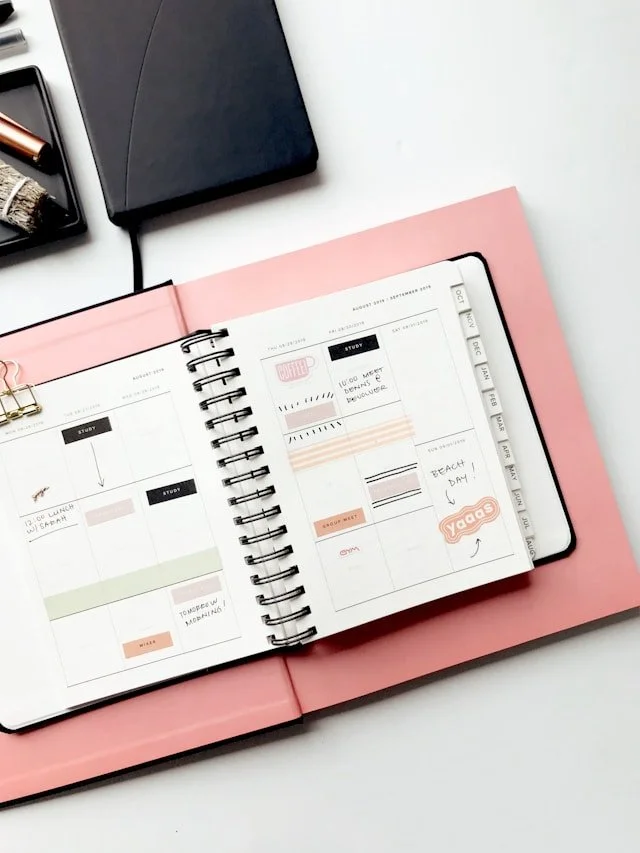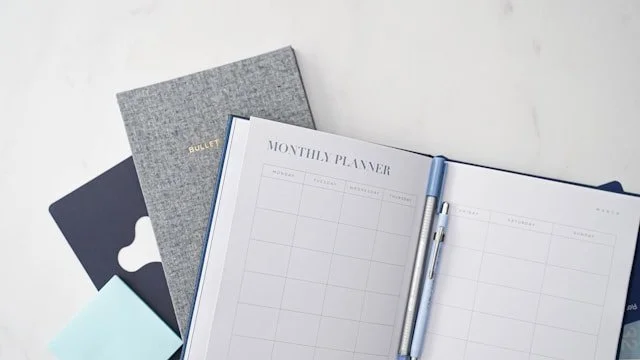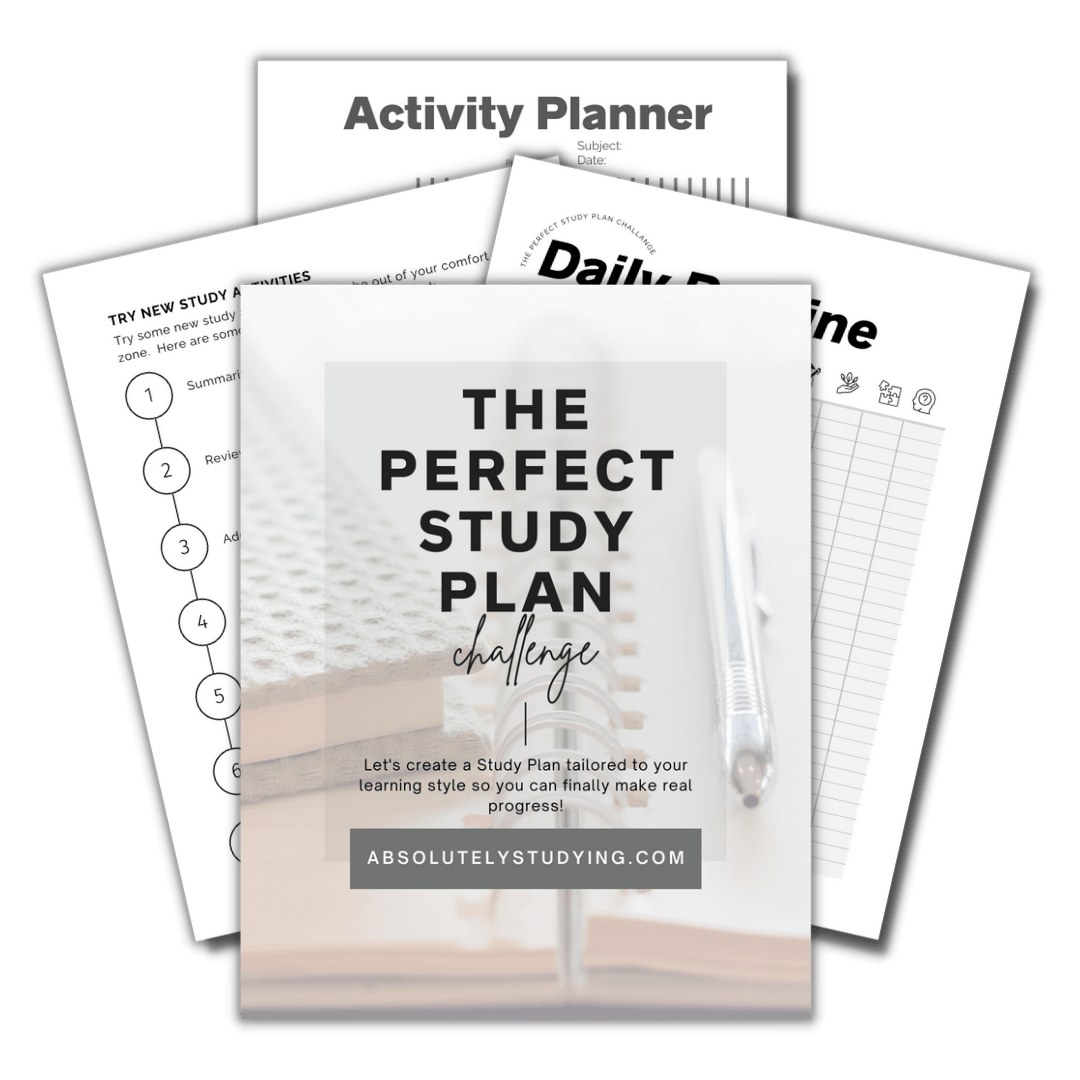Creating the Perfect Study Schedule for Your Unique Needs
Creating the Perfect Study Schedule for Your Unique Needs
Turn Your Goals into a Schedule You’ll Actually Follow
Everything you need for the semester you want!
This bundle includes:
The Syllabus Study Planner
The Pomodoro Planner
A Confidence Tracker
A Q&A planner
The “Get Organized Checklist”
and more!
This workbook is full of super useful resources that can be applied to every aspect of your day.
* Disclaimer * Some of the posted links are affiliate programs. By clicking these links, I may receive monetary compensation. This will not alter the price or change the buyer's experience.
Have you ever tried to follow someone else’s perfect-looking study routine and ended up feeling completely behind by day three… Yeah, same.
I can’t tell you how many times I’ve copied a Pinterest “study schedule for straight-A students,” only to realize it didn’t fit my life at all. Between family, work, classes, and the unpredictability of real life, rigid routines just don’t work for me.
And, if you’re reading this, I’m guessing they don’t work for you either.
That’s why this post isn’t about creating the most intense or aesthetic schedule. It’s about building a system that fits you. Your energy levels. Your lifestyle. Your goals.
We’re going to walk through how to create a study plan that actually works, specifically for your brain. One that helps you stay consistent without burning out, and one you can adjust without guilt when life gets messy.
Let’s ditch the pressure to do it “right” and figure out what works for you.
Before You Plan, You Need to Reflect
Before you can create the perfect study schedule, you have to figure out what “perfect” actually means for you. Spoiler: it’s not going to look like anyone else’s.
A personalized schedule isn’t about cramming more into your day. It’s about learning how you work best and building a plan around that.
Here are a few questions I asked myself before building my grad school study routine. These questions might help you figure out what you need too:
When are you naturally most alert? Morning? Afternoon? Midnight?
Do you focus better in short bursts or long, deep-dive sessions?
How much mental energy do you really have during the week?
What else is going on in your life outside of school?
Are there certain days where studying is impossible? (It’s okay to say yes.)
You’re not lazy if you can’t study for three hours straight.
You’re not behind if your brain works better at night than in the morning.
You’re human. And humans need schedules that work with their energy. Constantly fighting against your nature will only end in tears. Regardless of how many Insta-inspired aesthetic supplies you surround yourself with.
So before you colour-code anything, take 10 minutes to sit with these questions. The answers will help you build a study plan that fits your lifestyle. Not someone else’s impossible standards or idea of success.
Want a place to map all of this out? My free Study Planner & Activity Tracker has reflection sections and weekly layouts you can customize to your energy and time. You can grab it here if you need a starting point.
Time Blocking, Daily Goals, or Weekly Batching?
Once you know how you work best, the next step is choosing a study framework that actually fits your brain and your life.
This is where most of us get tripped up.
We try to copy rigid schedules from TikTok or Pinterest that assume we have endless motivation, zero distractions, and an internal clock that never malfunctions. (But you and I both know that none of that is realistic.)
So instead of forcing yourself to follow someone else’s method, here are three flexible frameworks you can use to build a study routine that works for you:
1. Time Blocking
If you like structure and need help staying focused, time blocking might be your best friend. It means assigning specific blocks of time to different tasks. It’s kind of like making appointments with yourself.
Example:
9:00–10:30 AM → Review class notes
2:00–3:00 PM → Flashcards + quiz practice
7:00–8:00 PM → Light reading or video review
This works especially well for students balancing work or family, because it helps you protect your time before life fills it up. Time blocking for students is a great way to stay consistent without overloading your to-do list.
2. Daily Goals
If your schedule changes a lot or you tend to rebel against rigid plans (hi, me too!), daily goals are a great option.
Instead of locking into a specific time, you just decide what you need to get done that day. Then you fit it in where you can.
Example:
☐ Finish textbook chapter 3
☐ Make summary notes
☐ Try 5 practice questions
This gives you the flexibility to adjust around your mood, energy, or unexpected plans.
3. Weekly Batching or Theme Days
This is great if you’re juggling multiple classes or assignments and want to avoid task-switching overload.
Example:
Monday = catch up + prep
Tuesday = reading + note review
Wednesday = deep study session
Thursday = practice problems
Friday = group work or chill review
Batching helps reduce decision fatigue and lets you build a rhythm without micromanaging every hour of your day.
The truth is, there’s no one “correct” way to study. The best study plan for students is one that feels sustainable. One you can stick to even when life gets messy.
And if none of these work on their own? Mix and match.
I use time blocking during the week and daily goals on the weekends. Do what works.
Let’s Make Your Study Schedule Make Sense
Okay, you’ve reflected on your needs, picked a scheduling method (or combo), and now you’re staring at a blank planner like… Cool. So what do I actually write down?
This is where a lot of people get stuck.
Building a study plan doesn’t mean packing every second with tasks. It means mapping out what matters and giving yourself the time and space to actually do it.
Here’s how I build mine, step by step.
Step 1: Start with the non-negotiables
Block in things you can’t change: classes, work shifts, appointments, family stuff. This gives you a realistic view of the time you actually have.
Step 2: Plug in your deadlines
Look at your syllabi (or what you already know is coming). Highlight exam dates, big projects, and weekly assignments. These are your anchors.
Step 3: Break things down
Take each deadline and reverse-engineer it. Ask yourself:
What do I need to do to be ready for this?
How many days or hours will that take?
Can I spread it out across a week or two?
Next, break it down. Instead of “Study for midterm,” your plan becomes:
☐ Review lecture slides
☐ Quiz yourself with flashcards
☐ Complete one past exam question per day
Step 4: Fit study sessions into your week
Now that you know what you need to do, you can assign those tasks to time blocks, daily goals, or batch days (from the previous section).
Pro tip: don’t fill every gap in your schedule. Leave room for life, rest, and unexpected chaos.
Step 5: Adjust every week
The best study plan for students isn’t one that stays the same all semester. It’s one that evolves with you. I revisit mine every Sunday, tweak what didn’t work, and shift things around when needed.
Flexibility Is Not Failure
Can I just say something that took me way too long to learn?
Missing a study session doesn’t mean you’ve failed.
Seriously. Life happens. You get sick. Your shift runs late. Your brain short-circuits, and you binge-watch five hours of Netflix instead of reviewing Chapter 7.
It doesn’t mean you’re lazy. It means you’re human.
That’s why your schedule has to have room to breathe. The most effective students aren’t the ones with perfect routines. They’re the ones with flexible study routines that bounce back when things go sideways.
Here are a few ways I build flexibility into my own plan:
1. Schedule buffer time
Instead of cramming every free hour, I leave a few empty blocks during the week. On purpose. That way, if something gets pushed back, I have space to catch up without spiralling.
2. Have a “minimum viable day”
On low-energy days, I don’t aim for perfection. I ask: What’s the one small thing I can do today to move forward?
Sometimes that’s re-reading my notes for 10 minutes. Sometimes it’s just updating my planner. It still counts. If you know you are making progress overall, allow yourself grace occasionally.
3. Expect to revise
Your routine will change. Your energy will shift. Your course load will surprise you. That doesn’t mean you did something wrong. It means you’re adapting.
The key isn’t doing it perfectly. It’s staying consistent over time.
At the end of the day, creating the perfect study schedule isn’t really the goal.
What you’re building is a system that supports you on your good days, your chaotic days, and the days when you’re just trying to make it through one class at a time.
If you’ve ever felt like a failure because you couldn’t stick to someone else’s routine… I hope this post reminds you that the best schedule is the one that fits your life.
Start small. Start flexible. Start messy, if you have to. But start.
You can download my free Study Planner & Activity Tracker to build your own personalized, realistic, flexible study routine. It’s designed for real life, not Instagram.
And if you’re looking for more structure this fall, the Perfect Study Plan Challenge launches in September. It’s a full 30-day reset with weekly printables, live check-ins, and gentle accountability. It’s designed to help you build a study system that sticks.
You don’t have to figure it all out today.
You just need one next step.
The Perfect Study Plan
Create your perfect study plan with me during this free 30-day challenge.
I would like to be transparent so that there are no misunderstandings. As an affiliate, I may earn a small commission from any products linked in this post. This is not a sponsored post, and I was not asked to recommend these products. These are products that I genuinely love and want to share with my audience.




